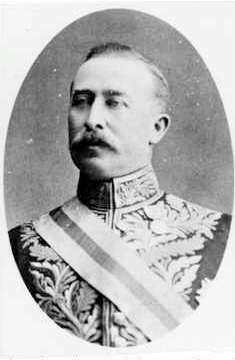Algernon Keith-Falconer, 9th Earl of Kintore facts for kids
Quick facts for kids
The Earl of Kintore
|
|
|---|---|
 |
|
| 12th Governor of South Australia | |
| In office 11 April 1889 – 10 April 1895 |
|
| Monarch | Queen Victoria |
| Premier |
|
| Preceded by | Sir William Robinson |
| Succeeded by | Sir Thomas Buxton |
| Personal details | |
| Born | 12 August 1852 |
| Died | 3 March 1930 (aged 77) |
| Nationality | British |
Algernon Hawkins Thomond Keith-Falconer was a British politician. He was also a colonial governor. He held many important titles. These included the 9th Earl of Kintore. He was also the Chief of Clan Keith. He was born on August 12, 1852. He passed away on March 3, 1930.
Contents
Who Was Algernon Keith-Falconer?
Algernon Keith-Falconer was an important figure. He served as the Governor of South Australia. This was from 1889 to 1895. He was known for his political work. He also had a military career.
Early Life and Education
Algernon Keith-Falconer was born in Trinity, Edinburgh. His birth took place at Lixmount House. He was the oldest son. His parents were Francis Keith Falconer and Louisa Madeleine.
He went to two famous schools. First, he studied at Eton. Then, he attended Trinity College, Cambridge. These schools prepared him for his future.
Starting His Political Journey
In 1880, Lord Kintore tried to become a Member of Parliament. He ran for the Conservative Party. He did not win the election in Chelsea.
Later in 1880, his father passed away. Algernon then inherited his father's titles. He became the Earl of Kintore. In 1885, he got a special job. He became the First Government Whip in the House of Lords. This meant he helped organize votes.
He also served as a Lord-in-waiting. This role meant he helped the Queen. He held this job from 1885 to 1886. He did it again from 1895 to 1905. In 1886, he joined the Privy Council. This is a group of important advisors to the monarch. In 1913, he became a Senior Deputy Speaker. This was in the House of Lords.
Leading South Australia
Lord Kintore became the Governor of South Australia. He served from 1889 to 1895. A Governor is like a representative. They act on behalf of the monarch. They help lead the government of a colony or state.
When he became Governor, he received an honor. He was made a Knight-Grand-Cross. This was part of the Order of St Michael and St George. He was also a freemason. He became the Grand-Master. This was for the United Grand Lodge of South Australia. He held this role during his time as Governor.
He arrived in South Australia on April 11, 1889. He traveled on a ship called the Orient. Chief Justice Samuel Way welcomed him. Samuel Way had been the Grand Master before him.
Life After Being Governor
After his time as Governor, Lord Kintore continued to serve. He was a Lord-in-waiting for Queen Victoria. He also served Edward VII. This was from 1901 to 1905.
In 1901, King Edward asked him for help. He went on a special trip. His job was to tell other countries about the new King. He visited Denmark, Sweden and Norway, and Russia. He also went to Germany and Saxony.
Lord Kintore was also involved in the military. He became a lieutenant-colonel. This was in the 3rd Battalion of the Gordon Highlanders. He also held the honorary rank of colonel. In 1903, he became an Aide-de-Camp to the King. This was for the Militia.
He received several honors from other countries. These included awards from Italy, Prussia, Portugal, and Sweden.
His Family Life
Lord Kintore married Lady Sydney Charlotte Montagu. She was the daughter of the 6th Duke of Manchester. They got married in London on August 14, 1873.
He had two sons and two daughters. His second son, Arthur, took over his title. This happened after Lord Kintore's death. His daughter, Lady Ethel Sydney Keith-Falconer, later inherited the earldom.
What He Left Behind: His Legacy
Many places and things are named after Earl Kintore. These honor his time as Governor. They include:
- The County of Kintore in South Australia. This was named in 1890.
- The town of Kintore, Northern Territory.
- Kintore, Western Australia, which is now a ghost town.
- Kintore Avenue in Adelaide city centre.
- A type of Australian lizard. It is called Kintore's egernia. It was named in 1893.
- Mount Kintore and the Kintore Range. These are in the Northern Territory. William Tietkens named them in 1889.
See Also
- Tietkens expedition of 1889

